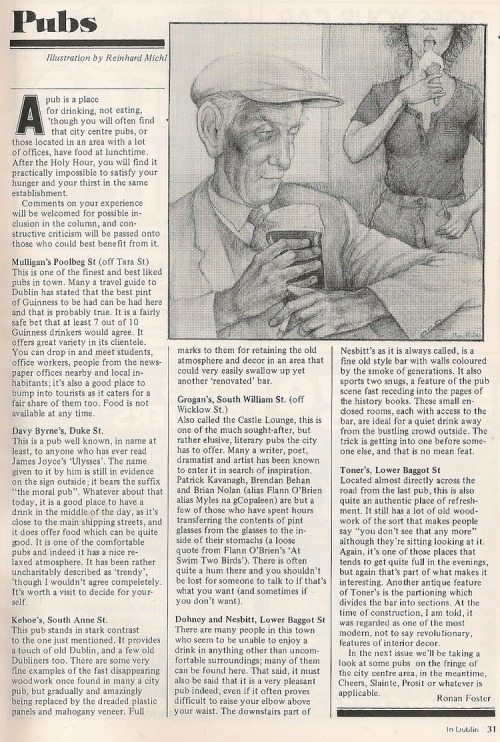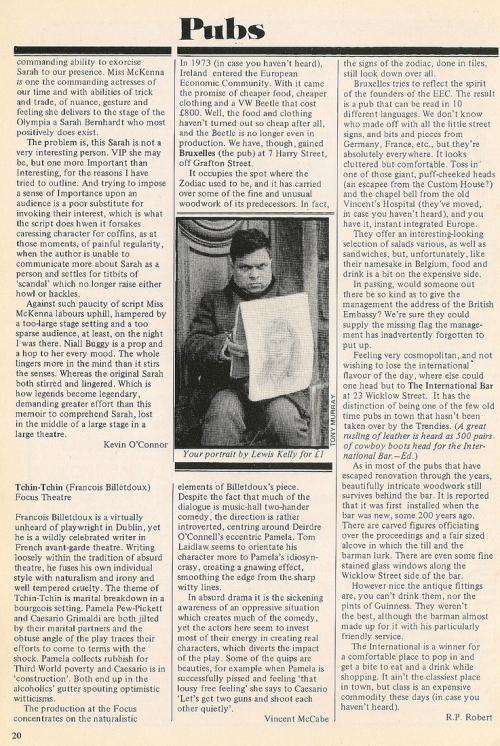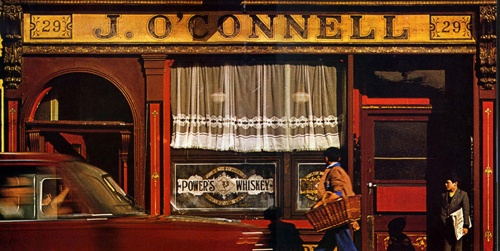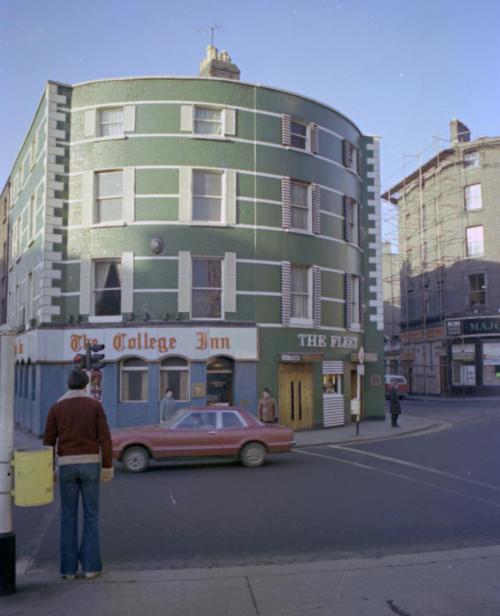Last year, a small group of us went on two rambles up the Dublin Mountains. The first was to the historic and spooky Hellfire Club.
![CHTM! at Hellfire Club, Jan 2013.]()
CHTM! at Hellfire Club, Jan 2013.
Here is a lovely aerial shot of the ruined hunting lodge that has been a source for all sorts of sordid tales for hundreds of years:
![Hellfire Club. Credit - source.southdublinlibraries.ie.]()
Hellfire Club. Credit – source.southdublinlibraries.ie.
The second trip (in tough snowy conditions) was to the spot where the mutilated body of Captain Noel Lemass (anti-Treaty IRA) was found in October 1923.
![CHTM! and friends at Noel Lemass memorial plaque, January 2013.]()
CHTM! and friends at Noel Lemass memorial plaque, January 2013.
We went on our first ramble of the year this month. Our journey took us from Rathfarnham up to the small plaque to mark where the body of Honor Bright was found in 1925, to Lamb Doyles in Sandyford at the foot of then Dublin Mountains and finally to The Blue Light in Barnacullia.
Our group of five met in Rathfarnham on what turned out to be a beautiful Saturday afternoon. One of the sunniest days of the month so far. We walked up through Kingston housing estate, crossed the M50 motorway and onto the Blackglen Road. Taking a sharp right onto Ticknock Road, we located the small plaque marking the place where the body of Honor Bright (real name Lily O’Neill), shot through the heart, was found on June 9th 1925.
![Small plaque. Photograph - Sam (CHTM!)]()
Small plaque. Photograph – Sam (CHTM!)
Lily, originally from County Clare, lived at 48 Newmarket in the Liberties and worked as a prostitute in the vicinity of the Shelbourne Hotel on Stephen’s Green. A mother of a young child, it was rumoured that she was forced to turn to prostitution after she was fired from her job for having a child out of wedlock. On the night of her murder, she was seen outside the Shelbourne talking to two men in a grey sports car. These were later identified as Dr. Patrick Purcell from Blessington, Co. Wicklow and a former Garda Superintendent, Leo Dillon from Dunlavin, Co. Wicklow. It was reported in the press that Dillon had served with both the British Army and Free State army.
That night, Dr. Purcell claimed to a number of people that he had been robbed earlier of £11 by a prostitute and that he was out looking for her. It was repeated in the newspapers that he told a cab driver that “‘if he got her he would put a gun through her mouth … (and) if he did not get her, some other girl would fall a victim”. One of the last people to see Lily alive was a taxi driver Ernest Woodroffe who came forward and said that he had dropped her to Leonard’s Corner, about ten minutes walk from her house, just after 2:30am. As the cab driver headed back towards the Green, he saw the distinct grey sports car drive past him, towards where he had just left the girl.
![From Sunday Independent, 7th July 1925.]()
From Sunday Independent, 7th July 1925.
Her body was found in the foothills of the Dublin Mountains at 7am. In an era when cars were scarce, the sports car was quickly traced to Dr Purcell who admitted being in the city on the evening Lily was murdered with Leo Dillon. The latter of which eventually admitted that he had ‘been with her’ that night but said he had last seen her getting into a taxi at St Stephen’s Green and driving off.
Although the taxi driver testified that he had seen Purcell’s car in the vicinity of Leonard’s Corner after dropping Lily and a Garda said he saw Purcell and Dillon with Lily speaking beside the grey sports car in Harold’s Cross later that night, the jury believed that there were a lack of sufficient evidence and acquitted the two men in just three minutes.
![From Sunday Independent, 30th July 1925.]()
From Sunday Independent, 30th July 1925.
Folk singer Peter Yeates wrote and recorded a song in memory of ‘Honor Bright’ in the early 1980s.
In December 2006, the following post was left by ‘Markao’ on a folk music lyrics site:
Honor Bright … left behind a son (Kevin Barry aged 5). The son was not mentioned in the police investigation or the trial. He left Eire aged 19, fought in the war, married a German girl in Wales, had 9 children of whom I’m number 5.
What became of the two accused? A poster (‘PLH’) on Boards.ie who said that she was also a granddaughter of Lily O’Neill wrote in July 2009 that:
Various stories have been offered about (Dillon’s) later life, for example, some say he traveled to the USA and committed suicide or was killed on disembarking. Others say he committed suicide in Ireland.
Partick Purcell was ostracised in Blessington after the trial and local shops refused to serve his wife. He found work as a doctor in Kent, England. Later his son of the same name also became a doctor, and he is now retired.
Poster ‘PLH’ also revealed some interesting information about the plaque that is located on a wall outside “Capilano” house on Ticknock Road. Rumour has it that the plaque installation was commissioned by the previous occupier of the house who had lived there since the murder. Prior to the plaque there was a small cross carved in to the wall stone sometime after the event. That stone was replaced by a ‘clean’ one and again shortly afterwards a further cross was carved.
![The 5 Lamps Dublin Brewery brought out an ale called 'Honour Bright' last year. Picture - untappd.com.]()
The 5 Lamps Dublin Brewery brought out an ale called ‘Honour Bright’ last year. Picture – untappd.com.
We then walked up to the short distance to Lamb Doyle’s pub. Opened in 1832 (according to one source), this large pub on the Blackglen Road, Sandyford was opened by a man with, as you can probably guess, the surname Doyle. As this was such a common name in the area, he needed a nickname. Described as a big man with a white beard, he had a very gentle demeanor – ‘as gentle as a lamb’ and so was called Lamb Doyle. The name stuck.
If you’re interested, other nicknames for Doyles in the Barnacullia area included:
Big Joe’s, Butler, Club, Cricket, Daddy, Dancer, Darby, Dooce or Douche, Dresser, Drummer, Fay, Feck or Fecker, Flier, Fogey, Fugs, Fussey, Gigger, Gipser, Gombo, Good Chap, Hearseman, Kipper, Luby, Mare, Matt, Nailer, Obetha, Power, Sandy, Shop, Slaney, Spiro, Straight, Sweeney, Tango, Tipper, Tosser, Turk, Wave, Willy.
Speaking of lambs, publican Dessie Hynes told author Bill Barich (‘A Pint of Plain’, 2010) that Lamb Doyles used to be popular with sheep ranchers and he often saw one particular farmer in the pub order a baby brandy and apply a “splash of it to the lips of any lamb in distress”.
Irish painter William Orpen, who used to frequent the pub often with his friend Oliver St. Gogarty, wrote in about 1911:
The view from the Lamb Doyle’s pub on a Summer’s morning as you sit in the shade on a bench outside the house and look back over the bay with Dublin on the left and Howth, Ireland’s Eye and Lambay behind, on the right, Kingstown, Dalkey and Bray Head, all of them in the blaze of the midday sun! The sweet smell of the country in your nostrils, a cigarette in your mouth, and your glass behind you. Truly you could feel life in all its’ glory.
From this period until the 1960s, the pub was a traditional country pub. The bar also served as the local grocery shop. Its floor was covered with sawdust and in winter there was a blazing fire of gorse.
Throughout this time, at weekends parties drove out from the city in horse drawn traps, sidecars, charabancs and then private cars to enjoy the mountain scenery and make use of the bonafide facilities. A bona fide house utilised a legal loophole, dating back to early coaching days, that allowed a genuine bonafide traveler three miles (five in Dublin) from his place of residence to drink alcohol outside normal hours. As Lamb Doyle’s is about eight miles outside the city, it was a popular place for revelers to travel to when the regular pubs in the city closed at 11pm.
It became something of a ‘hip’ spot in the 1960s. Spurred on obviously by an increase in private car ownership and people’s access to disposable income. In a column entitled ‘Dublin by Night’ in Trinity News (10 November 1966), the unnamed writer said that “winey nights for the really well-heeled are best enjoyed at Lamb Doyle’s or the Wicklow Hills hotel”.
![Lamb Doyle's, 1969. Credit - Brand New Retro]()
Lamb Doyle’s, 1969. Credit – Brand New Retro
A 1969 advertisement in ‘Publin – a selective guide to the pubs of Dublin’ promoted its:
de-luxe restaurant restaurant upstairs (booking essential in the season) with a dancefloor downstairs and down below comfortable bars with discreet comfortable television
After being taken over by Crosspan Properties in 1979, a £100,000 redevelopment followed. It was bought by the owner of Scruffy Murphy’s in 1992 for £750,000. A 2006 plan to demolish the premises and rebuild 41 apartments, two shops and a new pub on the site was rejected An Bord Pleanála. This was the second attempt by the Morton family to gain planning permission to build a scheme of a similar size.
![Lamb Doyles today. Credit - yelp.ie]()
Lamb Doyles today. Credit – yelp.ie
Without trying to sound too harsh, I think it is fair to say that Lamb Doyle’s heyday was in the 1960s and 1970s. The decor doesn’t seem to have changed much though and that is certainly not a compliment. The yellow walls had a incoherent display of Asian imagery, second-rate paintings of flowers and advertisements offering 3 pints of Tuborg for a bargain €10. Never usually a good sign.
The over-priced food was unexceptional, the clueless staff got one simple food order mixed up and the bland Guinness was not cheap at €4.70. While reading up that the present owners tried to demolish the place twice back in 2006, it’s not surprising perhaps that they aren’t as interested in the current set-up as they might have used to be.
We then made our way up the hill through the small, scattered village of Barnacullia to the Blue Light pub. Éamonn Mac Thomáis in his book ‘Janey Mack Me Shirt Is Black’ (1982) reckoned that in early part of the 20th century, there were “at least three hundred stone workers” in the village. Their craftmanship can be still seen in the masonry of cottages, walls and gate piers in the area. The quarry at Barnacullia, famous for its County Dublin granite, was used for many landmark buildings including Mullingar Cathederal, Cavan Cathedral and the Department of Industry & Commerce and the Department of Transport on Kildare Street.
In 1917, Irish Volunteer 1st Lieutenant Andrew McDonell (BMH WS 1768) was sent to organise the areas of “Ticknock, Barancullia and Glencullen”. He describes how Ticknock had to be “treated as a separate unit” as there was a feud going back over 50 years between the villages of Ticknock and Barancullia. Initially, as he was a ‘City man’, he was not trusted by some of the mountain men but one specific event changed all that:
![McDonell BMH WS 1768, p. 28]()
Andrew McDonell BMH WS 1768, p. 28
On our way to the Blue Light, we had a brief look for the ruins of Countess Markievicz’s cottage but could not find it.
![Countess Markievicz's cottage.]()
Countess Markievicz’s cottage. From Patrick Healy’s ‘Rathfarnham Roads’ (2005)
Patrick Healy wrote in his brilliant ‘Rathfarnham Roads’ (2005):
A short distance to the east and approached by a narrow lane is the remains of the house which was occupied by Countess Markievicz up to the time of the 1916 Rising. This cottage was taken by Countess Markievicz about 1907 and was visited by many whose names were later to become by-words in the national movement. During Easter Week 1916, the wife and children of James Connolly stayed here. The cottage was occupied down to about 1945 when the last tenant was moved to a council house. It was then condemned and the roof removed. A committee was later formed to restore the cottage as a memorial to the Countess but when they were informed that they would be required to rebuild the walls, the project was abandoned.
We then followed the road up to The Blue Light which stands 1,700 feet above sea level.
![View from Blue Light, January 2013. Credit - Sam (CHTM!)]()
View from Blue Light, January 2013. Credit – Sam (CHTM!)
Opened in c. 1870, the pub was formerly used as a private ‘lighthouse’ for Dublin Bay smugglers. Signals from the pub, including their blue window blinds, were visible miles out to sea and formed an important part of the elaborate intelligence network of martime smugglers who smuggled cargoes of brandy, wine, laces and fine silk past the Revenue-cutters of the Crown. Another story suggests that when the duty officials in Dunlaoghaire Harbour clocked off, a light signal would be sent to this premises. A signal would then be sent back out to the bay using an old blue ships lantern to let sea smugglers know that the ‘coast was clear’.
Bought for £300 in 1915 by a Mr. Walsh, he passed the pub onto his brother (known as the The Blue Light Man) and then onto his nephew Dick Walsh who put it up for auction in the late 1970s.
![The Blue Light, 1979. Credit - The Irish Times (13 July 1979)]()
The Blue Light, 1979. Credit – The Irish Times (13 July 1979)
On a side not, apparently it’s the last pub in Dublin that still sells turf!
For our first visit, we had a couple of pints in the lounge area at the back. When you come to the entrance, you take a right go into a room with a lovely fire and then it’s to your left. The service was great and the pints of Guinness at €4.20 were gorgeous. You could tell the place hasn’t changed in years, in a good way, and the decor was like a mini Aladdin’s Cave. Reminded us a little bit of the Hacienda and Frank Ryan’s.
We then headed for a ramble that brought us up the Dublin Mountains where there were spectacular views of the city.
![Overlooking Dublin. Photo from transmitter, Three Rock. Jan 2013. Credit - Sam (CHTM!)]()
Overlooking Dublin. Photo from transmitter, Three Rock. Jan 2013. Credit – Sam (CHTM!)
It was dark by the time we got back to the Blue Light. We decided to try out the bar this time around. Its entrance is straight ahead when you walk up the steps to the pub. This was dominated by locals and there were fascinating pictures on the walls of Barnacullia tug-of-war games and social events dating back to the 1910s. It felt like someone’s living room and the roaring fire soon warmed everyone up.
Highlighting once again that Dublin is such a small place, we bumped into Tommy Graham (History Ireland), his nephew and his nephew’s friend in the pub. After a couple more lovely pints (with Tommy selflessly abstaining), he kindly dropped us all back into the city centre.
Another great day out and we’re looking forward already to our next Ramble in a couple of months time.
![]()
![]()
![]()
![]()
![]()
![]()
![]()
![]()











































































































